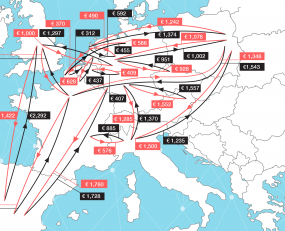
Wednesday 3rd February, 2021, Bath, UK – Ti and Upply’s European Road Freight Rate Benchmark Q4 2020 shows a drop in freight rates compared to the summer months as new restrictions and lockdowns weakened demand levels.
Following a flurry in activity during Q3, additional public health measures designed to slow the spread of the pandemic hampered the road freight recovery in Q4. This demand slowdown led to lower rates, both compared against Q3 2020 and Q4 2019.
There were some key differences compared to the first wave of the pandemic. Manufacturing facilities largely remained open, enabling related road freight activity to continue. These base levels were part of the reason why government support schemes, such as furlough, were not used to the same extent as before. We also did not witness the same painful border delays or driver displacement as had occurred when the pandemic was first spreading across the continent.
Brexit played a key role in influencing rates over the final quarter. Stockpiling prior to the end of the transition period was a feature, necessitating additional international road freight movements across the English Channel. UK rates grew by 1.1% year-on-year in Q4, contrasting against non-UK rates, which were 1.8% lower than prior year levels.
However, like elsewhere in Europe, demand in certain sectors, such as retail, suffered amidst further pandemic-induced restrictions. In addition to low diesel prices, this was key in pushing the benchmark rate down in the final quarter of 2020.
The slowing in demand was influential in shaping Europe’s major trade lanes, including Madrid-Paris and Duisburg-Lille. The same was largely true for Warsaw-Duisburg, although Q4 only served as a minor blemish against higher rates seen over the first nine months of the year.
Other lanes witnessed particularly sharp declines though, including Milan-Warsaw with a 16.9% fall year-on-year. Reduced congestion and more lenient HGV restrictions were key contributors to this sharp decline.
Turning to 2021, Brexit looks set to be a key influence in rates as the UK and EU settle into their new trading relationship. The report also looks at how the COVID recovery, diesel prices, sector changes, the Mobility Package implementation and supply shortages could influence rates across Europe in the year ahead.
With Rotterdam-Duisburg bucking the trend with a rate increase in Q4, the report asks whether the improvement can be sustained in the months ahead. This looks contingent on the shape of Germany’s COVID recovery and the extent to which Germany relies on China to aid its manufacturing rebound.
Andy Ralls, Quantitative Analyst at Ti, commented, “Greater stability in road freight supply has been a contrast with the first wave of the pandemic, forcing carriers to accept lower prices as demand slowed. However, it looks as if rates will start to increase in the near future, as vaccines are rolled out, diesel prices are likely to rise and Brexit bureaucracy costs are factored into prices.”
Thomas Larrieu, Upply’s Chief Data Officer, said, “While road transport prices decreased in 2020, we anticipate a steady recovery in 2021 driven by an expected increasing transport demand from Q2 2021. Key factors to monitor: fuel price, EU economic growth and balance between transportation offer and demand.”
About the European Road Freight Rate Benchmark
The European Road Freight Rate Benchmark report is designed to provide greater visibility of freight rate development across Europe. CLICK HERE to download the whitepaper.
If you have any questions about the report please contact Michael Clover, Ti’s Head of Commercial Development – [email protected].
You can join Ti and Upply for the European Road Freight Rate Development Benchmark Webinar, Wednesday 3rd February 2020, 15:00 CET.
The Webinar will feature Thomas Larrieu, Upply’s Chief Data Officer; William Béguerie, Road Transport Expert of Upply; Andy Ralls, Quantitative Analyst at Ti; and Michael Clover, Ti’s Head of Commercial Development, discussing the data trends and drivers behind:
CLICK HERE to register for the webinar and we’ll send you your invitation to join the live webinar at 15:00 CET on Wednesday 3rd February.
About Transport Intelligence (Ti): Ti is the world’s leading source of market intelligence for the logistics and road freight industry, providing data and analysis through its European Road Freight Transport report series, Global Supply Chain intelligence (GSCi) database and expert consultancy services. https://www.ti-insight.com
About Upply: Upply’s mission is to reset the fundamentals of the supply chain market to help each player unleash their potential. Upply directly connects road carriers to trusted shippers throughout France. They also enable supply chain professionals to overcome the volatility and inefficiency of the market though a set of data expertise solutions. Upply employs data scientists, logistics and IT professionals, and digital experts. Launched in November 2018, Upply is based in Paris. https://upply.com/en
Source: Transport Intelligence, February 2, 2021
Author: Transport Intelligence